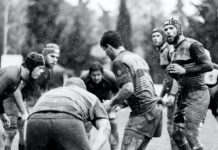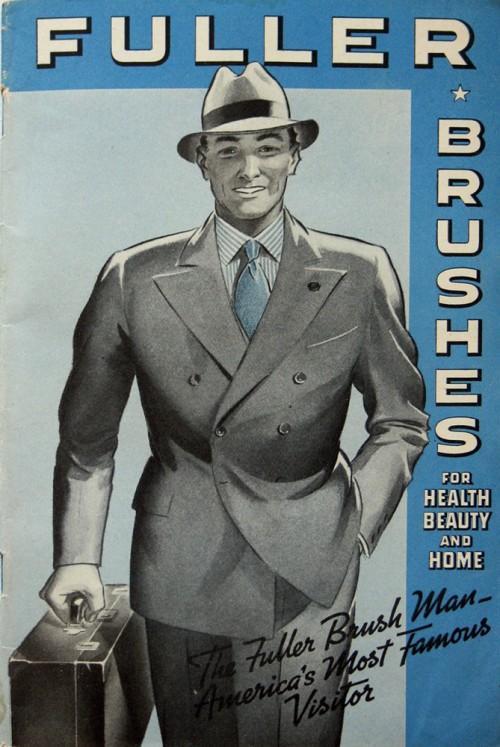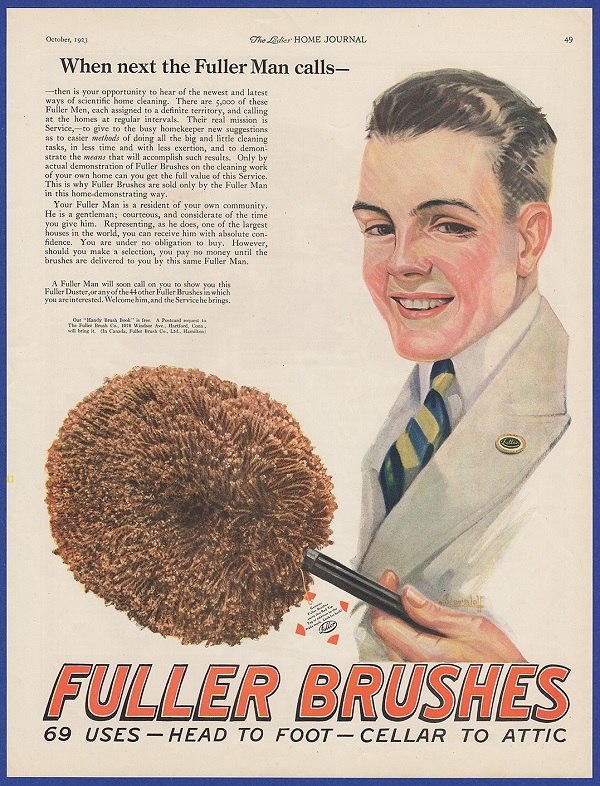The 1900’s saw a shift from Snake Oil and Pyramid Selling to a major milestone in sales methodology.
Methodology and Philosophy (1900 -1950s)
- Trust Based Selling – Improve professional image by building trust (1916 – DM Barrett / Patterson)
- Scientific Selling – Use phrenology to identify prime prospects (1916 – Phrenologists)
- Mood Selling – Use emotion to persuade customers to buy (1920’s – American Bible Society & American Bible Tract)
- Fuller Brush Men – Focused on people. Strong management helping sales teams (1920’s – Fuller Brush Co. / Alfred C. Fuller / Albert E. Teetsel)
- Psychological Selling – Learn to understand what makes buyers tick (1930’s – Dale Carnegie / Ford Motor Company)
- Barrier Selling – Get prospects to say ‘yes’ often enough to be trapped (1930’s – Insurance companies and Britannica Encyclopaedia)
- SELL – Tell-Sell process leading customer to a commitment (1940-50’s)
- ADAPT – Develop some pseudo technical jargon to keep buyers intrigued (1940-50’s)
- ARC – Cross selling and up selling in retail (1940-50’s)
1916
A major milestone in sales methodology development took place in 1916 when the first World Salesmanship Congress took place in Detroit (USA). Its constitution vowed the event was to “promote the dignity of salesmanship by the elevation of the rank of the salesman to a higher
plane” and to “encourage contributions to the science of salesmanship in the form of books, lectures, courses and publications.” The idea for the event came from D.M. Barrett, who was the editor of Salesmanship magazine and who had already organised a sales club in Detroit whose slogan was “Business betterment through betterment in salesmanship”. The keynote speaker at the congress was Woodrow Wilson, President of the USA at that time. Here we can see how individuals and organisations made the first attempts at making sales a more prestigious career and also at giving sales a rightful place within businesses.
Patterson (NCR) was one of the major sponsors of the World Salesmanship Congress. The sales methodology being promoted then, as the most effective of the day, and the message given to the more than three thousand salespeople who attended the congress, was that to be effective salespeople needed to build trust with customers. Earning and keeping the customer’s trust, attendees heard, “was the only way to promote the dignity of salesmanship, elevating the salesman to a higher plane…”
Even at this early stage in the evolution of sales methodologies, new sales techniques were being promoted as the answer to the challenges salespeople faced.
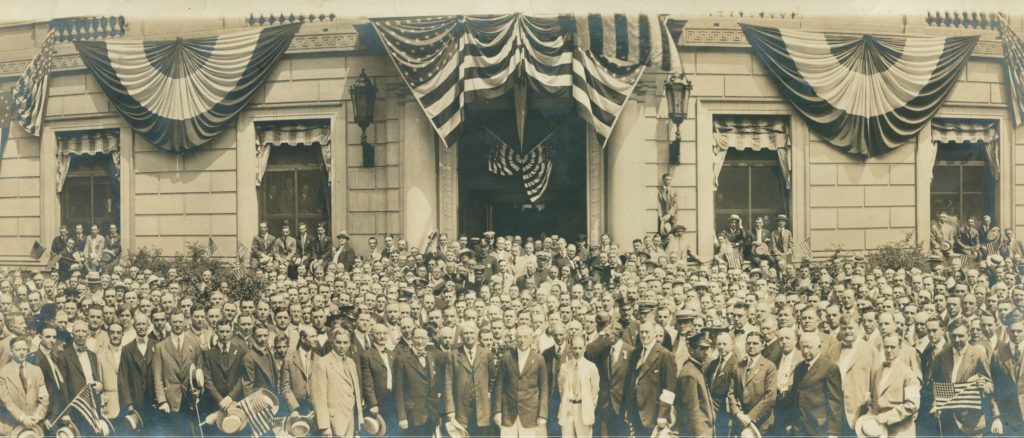
Amongst the more dubious people that introduced alternative sales methods at the World Salesmanship Congress was one Grant Nablo, a phrenologist (someone who is supposed to be able to read a person’s character by the shape of their skull). His proposed sales methodology
hinged on salesmen learning to read the character of their prospects by observing the shape of their skull. The basis of this sales method, proposed as the “introduction of Science in Selling”, was that if salespeople identified prospects with high foreheads they could improve sales for new products because these people (with high foreheads) were more imaginative than others and were likely to be early adopters, making selling new ideas, products and services easier and quicker.
So popular was the Science in Selling (phrenology) method that the Ford Motor Company produced a primer for its sales force – “Ford Products and Their” Sale (1923) that contained the following instruction: “Sell the vehicle according to the shape of the prospect’s head. High foreheads leave room for larger development and indicate people who are less likely to resist new ideas…”
1920’s
The great depression in the US, caused by the stock market crash of 1929, gave impetus to a range of sales methodologies as more and more people – struggling to earn a living – turned to selling simply because of the low barriers to entry into the craft. Although efforts to organise and standardise sales systems had started already, they were the realm of big corporations and mostly those operating in the B2B arena. This left the majority of people coming into the sales profession with little or no training at all from the companies they joined –organisations such as the American Bible Society and the American Tract Society– so they developed their own methodologies. The more successful of these enjoyed a period in the sunshine as the techniques spread and appeared to have some success. Amongst the more familiar – vestiges of which still continue in selling today – are the sales methods of:
Mood Selling which was introduced at the time of the depression. It was developed by bible salesmen who called door-to-door and, without any sales training, attempted to appeal to the emotions of buyers by claiming that the purchase of a bible would not only be good for the customer’s soul, but would help the salesperson stave off the starvation of his children.
This method of selling relied on an emotional pull to the people being sold to. Popular appeals were the saving of a soul (bible) and helping the salesperson feed their children (who these salespeople often took with them on their sales calls).
For a time, Mood Selling was a successful, though less than ethical, sales methodology. But customers and prospects started to see through the techniques being used and began to resist the appeals made by these “salespeople”. The change in buyer attitude forced salespeople to take stock of what they were doing and how they were selling.
Amongst the myriad of methodologies that came to play during this time, was that of the Fuller Brush Company. The company had been founded in 1906 by Alfred C. Fuller, who would both manufacture the brushes by night and sell them by day. In 1908, his wife joined him in his selling efforts and had better results than he did on her first day, and almost every day for a couple of years. By the 1920s The Fuller Brush Company had people all over the country going door-to-door selling brushes. But there was something different about these salespeople. Fuller provided them with training on a system that gained them entry to the houses they called on almost every time. The sales method had been developed by Alfred C. Fuller and refined with the collaboration of his sales managers. Every call started with presenting a gift to the housewife, followed by a demonstration of their products – Fuller had worked out early on that the key was to sell what the brushes could do for his clients, not the brushes themselves. In 1922, these men started to be known as the “The Fuller Brush Men”. They were not employed by the company, they were distributors. They each had a territory and the tools and processes they needed to be successful. One of the most talented managers was Albert E. Teetsel who brought to the company the concept of positive thought. He encouraged every salesperson to always reply to “How are you?” with “Fine and dandy”, underscoring the company’s most distinctive feature – its emphasis on people. Each distributor had to sign a pledge which said, amongst other things, that the salesperson’s “obligation is one of
service to the customer, to the company I represent and to the community in which I live and work.”, and, “I will be courteous; I will be kind; I will be sincere; I will be helpful.” The commercial and popular success of the company was built on the focus on its people, in particular, the sales team.
1936
In 1936 the iconic book ”How to Win Friends and Influence People” was published, catapulting Dale Carnegie to the head of the line of sales gurus. The huge success of his book is still being felt today and many of the modern sales techniques (including the concept of Customer Centric and Relationship Selling) have Carnegie to thank because they haven’t ventured too far from what he propagated as the way to effective relationship building and successful selling.
With everyone in sales trying to win friends and influence people, the advent of commission and sales incentives changed the paradigm once again and launched what was a successful, but massively flawed, sales methodology – Barrier Selling. This powerful technique evolved at the same time as salespeople were making the adjustment from earning a base salary to commission as an incentive for sales performance. The technique pushed salespeople to manipulate their customers.
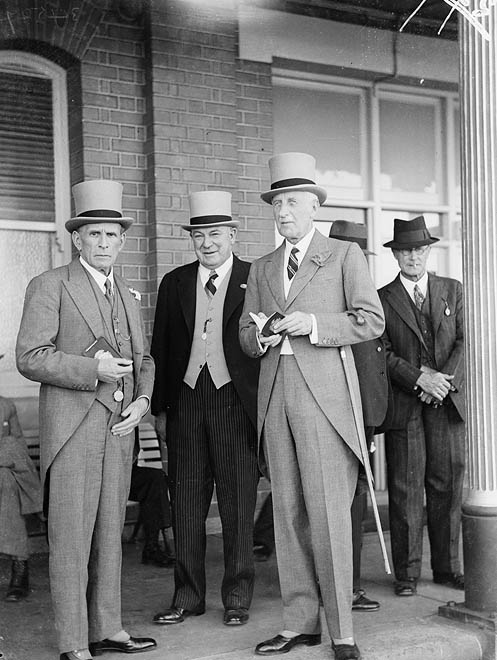
1930s at Randwick Races NSW
(Source – NSW State Library)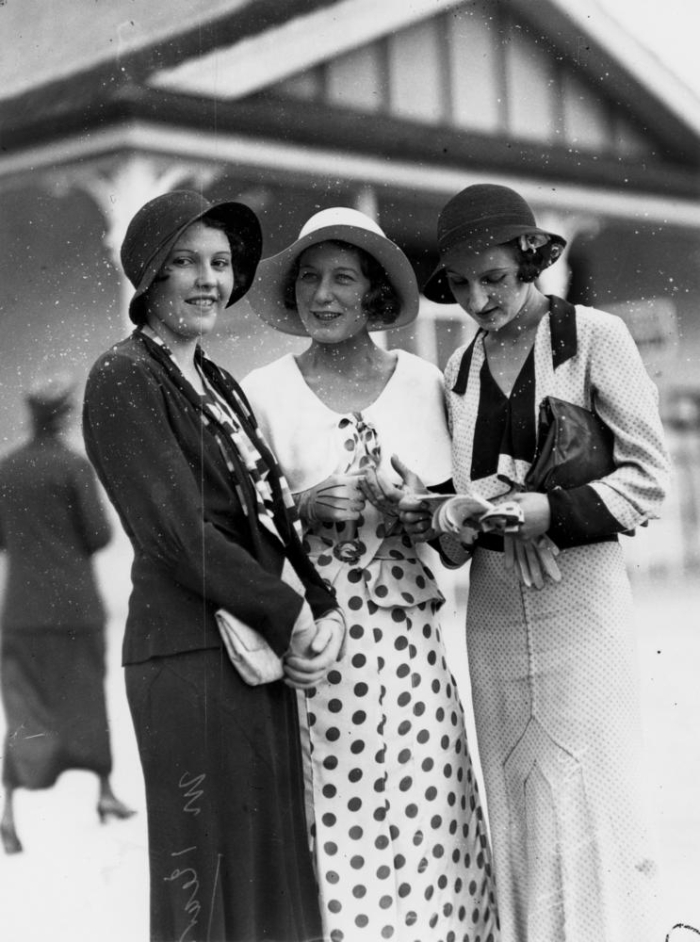
1930s at Ascot Races Queensland
(Source – QLD State Library)
Barrier Selling was (is) the sales method of asking customers leading questions to which the most logical answer would be “Yes.” Salespeople would ask several questions getting a string of affirmative (yes) responses before throwing in the key question “And of course, you want us to deliver this widget early next week?”
In using this method, two factors worked against the customer. One was the fact that salespeople seldom applied it without a spouse or child being present. So, for example, insurance salespeople – who were (and still are) notorious for using this technique – would never sell life insurance to a partner without the spouse being present. The kind of questions asked would be something like: “Obviously if something happened to you, you would want your partner to be looked after. Wouldn’t you?” It is unlikely that the person would say no in any circumstances, but even less so, with the partner present. Britannica Encyclopaedia salespeople were no different. They wouldn’t attempt to sell a set of Britannica without the
children being present. And the questions used to “trap” the buyer would be something like: “Obviously you want your child to have the very best education possible, don’t you?”
At the time that this technique was popular, salespeople still had a large role to play in providing information. Customers had little choice, limited access to information and relied heavily on what salespeople said and did, in order to learn about new products and services. In addition, there weren’t laws and controls to prohibit salespeople or protect consumers from this type of behaviour. Caveat Emptor – “let the buyer beware…” was the consumer mantra of the day. Salespeople made claims and promises, used techniques and methods simply to get a deal. And they did so with impunity and little fear of consequence. Because a large portion of a
salesperson’s income at the time (very often as much as 90%) was based on their ability to close the deal, salespeople were willing to risk everything with little thought to how customers felt or suffered as a result of their activities.
So destructive was this method of selling that governments introduced the cooling off period, allowing people to cancel agreements entered into under these circumstances.
1930s to early 1950s
In the period from around mid 1930s to early 1950s, just after the decline in the popularity of Barrier Selling, a range of alternative selling methods of little effectiveness, appeared on the scene. Each of these represented a different approach to selling that claimed, at the time, to revolutionise the way salespeople performed. Some of the more popular of these included:
SELL – Show, Explain advantage, Lead to benefit, Let them talk
This method encouraged salespeople to the Tell-Sell approach. Salespeople told their prospects success stories, in the process showing features of their products, explaining the product’s advantages and how other customers became successful or achieved staggering results (benefits) as a result of using this products.
ADAPT – Assessment, Discovery, Activation, Projection, Transition
Adapt was an acronym that became popular around the 1950s in Britain as a means of interacting with customers and prospects. The focus of this (at the time) popular method was to undertake some form of pseudotechnical assessment. The salesperson gave the appearance of using some methodology to assess the prospect’s business issues, though none of the records actually illustrate how this assessment was actually conducted. Once the assessment had been conducted, salespeople then directed the sales call, hoping that the prospect would discover how a product would benefit them. Once this discovery was made the salesperson would request a commitment which would transition the buyer from prospect to customer.
ARC – Ask, Recommend, Cross-sell and Close
In the early 1950s a sales method, uniquely designed to improve retail sales situations, evolved. ARC encouraged salespeople to ask customers what they wanted and then to introduce additional items to complement the initial interest. This method of cross-selling improved sales performance and enabled salespeople to increase the size of the original order. It wasn’t long before ARC spread to other areas of selling. Even in business-to-business selling the idea of cross-selling found traction and enabled salespeople to expand share of wallet. This technique was later used as part of Strategic Selling (Miller Heiman, 1975) to help salespeople cross and up-sell, and in the process increase share of wallet.
Coming up soon:
The History of Sales Methodology – Part 2 (late 1950s – 1980s)














